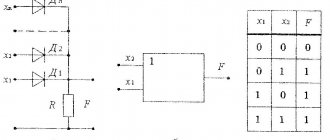Part 1. Identification of the problem
Why am I doing this? I just want comfortable light in my apartment (office), I don’t want to strain my eyes looking at small objects, I want my eyes not to get tired from working for a long time behind the screen. Many of my friends and relatives told me “thank you very much!” for “opening my eyes” to alternative light sources.
Start of research
From the moment I completely switched to MGL at home, and replaced the accent light with 9xx series fluorescent linear lamps and PL-E 8W CFLs, my tolerance to LED lighting has sharply decreased. I thought that this was just my perception, but no - my wife and friends, who also removed almost all LEDs from the house, said the same thing.
Together with my partner in this project, research was carried out in the field of artificial lighting. He expressed his point of view in the video. Thus, we offer you two views on modern lighting for consideration.
Quite a lot of material has been reviewed, but almost all publicly available scientific research is based on the same thing:
- a group of 50-100 people and they said how comfortable it was in the room under the light source being studied;
- count cones and rods in isolation from the “programmed” processing of data by the brain;
- do not take into account the insolation of the region, time of year and lifestyle;
- refer to the color rendering index CRI where the standard is both an incandescent lamp and the daytime sky (an incandescent lamp is weak in illuminating blue tones, and the sky at 7500 K is weak in illuminating red tones);
- have not studied the Purkine Effect applicable to LED lighting;
- based on the spectral luminous efficiency of monochromatic radiation - who decided that the rest of the spectrum was not needed is a mystery:
“The spectral luminous efficiency function weighs the perceived intensity of light at different wavelengths based on the sensitivity of the human eye to the wavelength of light. The human eye has maximum sensitivity to light with a wavelength of 550 nm in the green-yellow part of the visible spectrum and is less sensitive at its red and blue edges." *directory LED lighting
In 1924, the International Commission on Illumination (CIE) adopted this set as a standard, after which it became internationally recognized and is used as such until the present day. In the Russian Federation, this standard is also valid.
Operating principle of LEDs
Any LED has a pn junction. Glow occurs when electrons and holes recombine in an electron-hole transition. A Pn junction is created when two semiconductors of different types of electrical conductivity are connected. The n-type material is doped with electrons, the p-type with holes.
When voltage is applied, electrons and holes in the pn junction begin to move and take up space. When charge carriers approach the electron-hole junction, electrons are forced into the p-type material. As a result of the transition of electrons from one energy level to another, photons are released.
Not every pn junction can emit light. For light to pass through, two conditions must be met:
- the band gap should be close to the energy of the light quantum;
- the semiconductor crystal must have a minimum of defects.
It will not be possible to implement this in a structure with one pn junction. For this reason, multilayer structures are created from several semiconductors, which are called heterostructures.
To create LEDs, direct-gap conductors with a permitted direct optical zone-to-zone transition are used. The most common materials are A3B5 (gallium arsenide, indium phosphide), A2B4 (cadmium telluride, zinc selenide).
The color of a light-emitting diode depends on the bandgap in which electrons and holes recombine. The larger the band gap and the higher the energy of the quanta, the closer to blue the emitted light is. By changing the composition, it is possible to achieve luminescence in a wide optical range - from ultraviolet to mid-infrared radiation.
LEDs in infrared, red and yellow colors are made on the basis of gallium phosphide, green, blue and violet - on the basis of gallium nitrides.
Preparing for the study
Actually, let’s return to the title of this article “LEDs - blinding darkness”, this is the most complete description of the effect that was discovered. I want to say right away that this applies only to regions with low insolation and the autumn-winter-spring season.
With the massive transition to LEDs, in grocery stores it has become difficult to distinguish unwashed green potatoes from normal ones. But the understanding of what was wrong came precisely in the metro, where they began to switch en masse to LED lighting, and the floors and walls were lined with marble or granite .
Let me give you a few measurements taken “quickly” in the subway. I did not use a specialized lux meter, but limited myself to the Physics Toolbox Sensor Suite smartphone software, this software on my Xperia 1ii smartphone gives an error of about 15% in the measurement (when compared with the Radex Lupin lux meter), the maximum brightness level is 20000 lux, but since it is important for the experiment The difference is in brightness, not accuracy, then this application is sufficient.
Unfortunately, the camera sees the world differently , so you won’t be able to capture this effect . Don’t forget about the inertia of vision and adaptation to lighting; the ideal option is to be under a light source for at least 15 minutes.
The measurements were carried out “by hand”, so the amount of light falling on objects and reflected from them is not examined, but in this case this does not affect the results. The essence of the experiment is to prove that at the same illumination <500 lux with LED lighting the detail is lower.
Laser diodes
Laser devices are a separate type of LEDs that are neither indicator nor lighting. And the technology for its creation bears little resemblance to the production of standard LED elements.
Essentially, this is a semiconductor laser, which is built on the basis of an LED. When turned on, they emit a very narrow beam of light. Modern devices have a scattering angle of 5 to 10°. There are devices on sale that operate in the visible range, as well as infrared and ultraviolet laser diodes.
Such crystals are installed in laser pointers, target designators, optical disk drives, optical mice, etc.
Study
- St. Petersburg metro
From the many stations we chose: Sadovaya, Sennaya Ploshchad and the Technological Institute station.
Sadovaya station is illuminated with t5 fluorescent lamps (color temperature 3000k), the illumination in the lobby is ~ 150 lux - we look carefully at the marble/granite, the textures on it are clearly visible, thin veins are visible.
example of measuring brightness with a smartphoneNow we move to the Sennaya Ploshchad station, the bright light begins to “hurt” the eyes (color temperature ~4000k), illumination > 360 lux - we look at the floor and walls, the contrast pattern is clearly visible, but small details and halftones merge, and you have to strain your eyes when This gives the surface a lot of glare.
Technological Institute station (as of December 8, 2021) - illuminated by MGL lamps (of varying degrees of “fatigue”), illumination ~200 lux - the pattern and small veins on the marble/granite are very clearly visible, the detail is higher than when illuminated by fluorescent lamps.
- Home experiment
To experiment at home, you will need an incandescent lamp, I highly recommend using low-voltage halogen lamps, a thick spiral and rated voltage will give a more pleasant spectrum, with a lot of violet and green in the spectrum, it is better to use warm LED lamps, you can also add a high-quality fluorescent lamp for comparison.
The essence of the experiment is extremely simple: create illumination of 200 lux and 800 lux, see how small objects and complex textures look under this light. This effect will increase over time. This experiment is best done in the evening, when the sun has already set below the horizon.
How to determine voltage and polarity
An LED only allows current to flow in one direction. Therefore, it is important to connect the device to the circuit correctly. To do this, you need to determine which of the body terminals is the cathode and which is the anode.
- Visually , traditionally the cathode leg is short and the anode leg is long. The cathode has a minus sign, the anode has a plus sign. You can find the cathode in another way. Looking carefully through the case, you can see the crystal on the stand. The output of the stand will be the cathode.
- Connecting to a power source - select a device whose voltage is not higher than the permissible voltage for the LED. Usually this is a battery or resistor. When positioned correctly, the LED glows brighter.
- Using a multimeter - set the scale on the device to resistance measurement mode and touch the leads to the LED terminals with the probes. The contact is very short. When connected in reverse, the multimeter does not show anything; when connected correctly, it measures the resistance in the region of 1.7 kOhm.
The LED voltage does not need to be measured. This is a reference parameter; it is indicated in the passport. But if the document is lost, you can estimate the voltage with a quick multimeter. To do this, set the device to the “break test” mode and touch the leads one by one with the probes.
Intermediate output
In order to see small objects or surface textures, you have to strain your eyesight or greatly increase the brightness of the LED lighting, which leads to unwanted reflections of the surface and directly affects energy savings and energy efficiency; the consumption of vitamin A in the body also increases greatly (more on this in the next article ). And this is affected by violet, UV-A, near infrared. Don’t forget about the “software” processing of data by the brain; apparently, the edges of the visible spectrum are some kind of trigger that the sun is in the sky.
I would like to give a table of the efficiency of popular light sources; to be honest, I’m tired of advertising LEDs with an efficiency of 90%.
*1 this table is from 2010
Considering that the new HiCRI LEDs are made on a blue crystal of 460 nm, and not 440 nm, as before, we have an even more “compressed” visible spectrum. Who decided that this was “enough” for human vision is a big mystery. It was from the very beginning that man lived under sunlight and the eye adapted to it.
Based on the data in the table, we can conclude that the lamp with the most complete spectrum, close to the sun, is the MGL lamp.
LED indicators
To choose a suitable indicator LED element, you need to familiarize yourself with their types and types. This group includes the following types of diodes: DIP, Super Flux “Piranha”, Straw Hat, SMD. They all differ in design, size, brightness of radiation, etc. They are used in different fields.
DIP LEDs
This is a type of light-emitting device that has an output housing and often a convex lens. Different types of LEDs from this group differ in the shape and diameter of the housing. Cylindrical elements have a bulb circumference of 3 mm. Also on sale are diodes with a rectangular body.
They have a wide spectral range and come in single-color and multi-color (RGB tapes). However, their luminescence angle does not exceed 60°.
Why warm light?
Why are warm lamps better? There is this graph of lighting “comfort” depending on the CG floating around on the Internet - the Kruithof curve
Kruithof curve
The Kruithof curve does not contain the actual data that became the basis for its construction, but only indicates the approximate ratio of illumination and color temperature for comfortable artificial lighting. In this regard, the scientific value of the curve is ambiguous.
It clearly shows that if we want “comfortable” cold light, then the illumination should be > 1000 lux in the room , and this is already expensive. Believing this or not is a matter of purely personal opinion - for example, I agree with her, with only one condition - this graph is completely unsuitable for LED lighting.
LED device
LEDs are semiconductor devices with an electron-hole junction that creates optical radiation when an electric current is passed through it in the forward direction.
The light emitted by an LED lies in a narrow range of the spectrum. In other words, its crystal initially emits a specific color (if we are talking about LEDs in the visible range) - in contrast to a lamp that emits a wider spectrum, where the desired color can only be obtained by using an external light filter. The emission range of an LED largely depends on the chemical composition of the semiconductors used.
What's next
For fans of LED lighting disappointed by this article, I can only recommend SORAA VIVID, costing >2000 rubles for 470 lumens, which corrects some of the problems of LED lighting at the cost of reducing light output to <50 lumens per watt, but the problem of rapid degradation of the phosphor remains, and for those who wants to get truly comfortable lighting, I suggest you wait a little .
Soon -
Color characteristics
Light has a wave nature, the wavelength of the emitted wave determines the color and is measured in nanometers (nm). The human eye is capable of perceiving a range from 380 to 760 nm, which corresponds to the visible spectrum.
Color characteristics table
It is noteworthy that the human eye has the greatest sensitivity at 555 nm, therefore, a source with this parameter will have the highest degree of illumination.
Kinds
LEDs currently available are of the following types::
- indicator - with low power, for illumination in devices;
- lighting - with high power, the level of illumination corresponds to conventional (fluorescent and tungsten) light sources.
According to the type of connection, indicators are divided into:
- triple AIGaAs (aluminum – gallium – arsenic) – orange and yellow light in the regions of the visible color spectrum;
- triple GaAsP (gallium – arsenic – phosphorus) – yellow-green and red light in the visible spectrum;
- double GaP (gallium - phosphorus) - orange and green light in the visible spectrum.
LED elements differ by housing type:
- DIP - equipped with a built-in optical system consisting of a lens, a crystal and a pair of contacts. An outdated model of the lowest power, used for illuminating toys and light displays;
- Superflux or “piranha” - similar to DIP, equipped with four contacts, fits better and heats up less due to the heatsink for the LED. Used for lighting in cars;
- SMD is the most common type for many light sources. They are a chip (crystal) mounted directly on the surface of the board;
- COB – advanced SMD LEDs. Equipped with several crystals (chips) installed on one board. Mounted on ceramic and aluminum bases.
Photo of a lamp with new types of SMD LEDs
More advanced COB models still cannot always replace SMD LEDs.
Colorful temperature
This characteristic is derived by analogy with the color perception of heated metal. Numerical limits range from 800 to 7500 and are measured in Kelvin (K). Red light has the lowest indicator - about 800 K, respectively, the highest is cold blue.
White light is used for lighting. Colored LEDs are mainly used for decorative and display purposes. According to color temperature criteria, white color is divided into three subcategories:
- Warm – 2700 – 3500 K.
- Neutral – 3500 – 5300 K (the most balanced for perception).
- Cold – 5300 – 7500 K.
Lifetime
This parameter indicates the expected operating time of the LED crystal. The indicator LEDs have a lifespan of up to 100,000 hours. For ultra-bright sources this figure is a maximum of 60,000 hours. Manufacturers from the Middle Kingdom often overestimate this figure.
To extend the service life, it is necessary to observe the operating temperature of the ice lamp. In other words, the more efficient the cooling, the longer the source lives.
For visual reference, it is recommended to watch the video. The author of the video, in just a few minutes, succinctly describes the main parameters and characteristics that are really important when choosing LEDs.
Maximum operating temperature
Operating temperature is one of the most important characteristics of an LED. During operation, a large amount of heat is generated, an excess of which can initially lead to a drop in the intensity of light emission, and subsequently to complete damage to the LED. Some super-bright crystals can heat up to temperatures of 150˚ C.
Manufacturers have introduced the concept of “maximum operating temperature” to determine the temperature limits in which the operation of the ice source will be optimal. The permissible temperature values are indicated in the general passport data.
To combat excess temperature, aluminum and copper heat sinks are used. Low-power SMD LEDs are mounted on a board (substrate), which also acts as a cooler. For improved heat transfer, the junction of the LED and the heatsink is lubricated with thermal paste.










